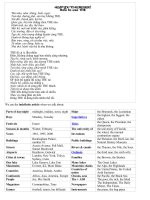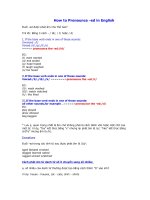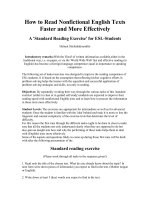doing business 2007 how to reform
Bạn đang xem bản rút gọn của tài liệu. Xem và tải ngay bản đầy đủ của tài liệu tại đây (339.34 KB, 39 trang )
Economy Profile
Iceland
Middle East and North Africa
A project of the World Bank and the IFC comparing business regulations in 175 economies
Economy Profile
Doing Business 2007 Middle East and North Africa
A Project Benchmarking the Regulatory Cost of Doing
Business in 175 Countries
Doing Business Project
World Bank Group
© 2006 The International Bank for Reconstruction and Development / The World Bank
1818 H Street, NW
Washington, DC 20433
Telephone 202-473-1000
Internet www.worldbank.org
The findings, interpretations, and conclusions expressed herein are those of the author(s) and do
not necessarily reflect the views of the Board of Executive Directors of the World Bank or the
governments they represent. The World Bank does not guarantee the accuracy of the data included
in this work.
Rights and Permissions
The material in this work is copyrighted. Copying and/or transmitting portions or all of this work
without permission may be a violation of applicable law. The World Bank encourages dissemination
of its work and will normally grant permission promptly.
For permission to photocopy or reprint any part of this work, please send a request with complete
information to the Copyright Clearance Center, Inc., 222 Rosewood Drive, Danvers, MA 01923, USA,
telephone 978-750-8400, fax 978-750-4470,
www.copyright.com.
All other queries on rights and licenses, including subsidiary rights, should be addressed to the
Office of the Publisher, World Bank, 1818 H Street NW, Washington, DC 20433, USA, fax 202-522-
2422, e-mail
To order copies of the
Doing Business 2007: How to Reform
Report, please visit
and click on “Now Available: Doing Business 2007: How to Reform”.
Contents
Doing Business 2007: How to Reform
: An Introduction 5
Economy Rankings: Ease of Doing Business Index 6
Reforms: Who is reforming? 7
Starting a Business: Entry Regulation 8
Dealing with Licenses: Building a Warehouse 11
Employing Workers: Labor Regulation 14
Registering Property: Regulation of Property Transfers 17
Getting Credit: Legal Rights and Credit Information 20
Protecting Investors: Corporate Governance 23
Trading Across Borders: Imports and Exports 25
Enforcing Contracts: Court Efficiency 29
Paying Taxes: Tax Payable and Compliance 32
Closing a Business: Bankruptcy 35
MENA
Introduction
Doing Business 2007: How to Reform
is the fourth in a series of annual reports investigating
regulations that enhance business activity and those that constrain it.
Doing Business
presents
quantitative indicators on business regulations and the protection of property rights that can be
compared across 175 economies—from Afghanistan to Zimbabwe—and over time.
Regulations affecting ten areas of everyday business are measured: starting a business, dealing
with licenses, employing workers, registering property, getting credit, protecting investors, paying
taxes, trading across borders, enforcing contracts and closing a business. The indicators are used
to analyze economic outcomes and identify what reforms have worked, where, and why.
The data for all sets of indicators are benchmarked to April 2006. Based on research of laws and
regulations, with input and verification from local government officials, lawyers, business
consultants, accountants and other professionals routinely administering or advising on legal and
regulatory requirements, this methodology offers several advantages. It uses factual information and
allows for multiple interactions with local respondents, clarifying potential misinterpretations of
questions. It is inexpensive, so data can be collected in a large sample of economies.
Because the same standard assumptions are applied in the data collection, which are transparent
and easily replicable, comparisons and benchmarks are valid across economies. And the data
highlight not only the extent of obstacles, but also help identify their source, supporting
policymakers in designing reform.
The methodology has limitations. Other areas important to business—such as a country’s proximity
to large markets, quality of infrastructure services (other than services related to trading across
borders), the security of property from theft and looting, the transparency of government
procurement, macroeconomic conditions or the underlying strength of institutions—are not studied
directly by
Doing Business
. To make the data comparable across economies, the indicators refer to
a specific type of business—generally a limited liability company operating in the largest business
city.
The data set covers 175 economies and is benchmarked to April 2006. The sample includes 23
high-income OECD economies as benchmarks, 45 from Sub-Saharan Africa, 23 from East Asia and
the Pacific region, 28 economies from Europe and Central Asia, 31 from Latin America, 17 from the
Middle East and North Africa, and 8 from South Asia.
The following pages present the summary
Doing Business
indicators for the MENA region. Further
information is available in the full report
Doing Business 2007: How to Reform.
which presents the
indicators, analyses their relationships with economic outcomes and recommends reforms. The
data, and information on ordering the report, is also available online at
.
5
Economy Rankings—Ease of Doing Business
MENA—Compared to Global Best / Selected Economies
Aggregate Rankings of Doing Business Indicators
Source: Doing Business Database
165
86
80
78
77
55
46
38
26
1
145
98
115
119
116
161
127
130
0 35 70 105 140 175
Egypt
Djibouti
Iraq
Syria
West Bank and Gaza
Iran
Algeria
Morocco
Yemen
Lebanon
Tunisia
Jordan
United Arab Emirates
Oman
Kuwait
Saudi Arabia
Israel
Singapore
T
op Rank - Global
Note: The ease of doing business index averages economy rankings across the 10 topics covered in
Doing
Business
2007
. The methodologies for some indicators have changed. Previous year rankings have been
recalculated with the new method and are available on the website:
www.doingbusiness.org.
6
Reforms—Who is reforming?
MENA—Compared to Global Best / Selected Other Economies
Net number of reforms that improve a set of
Doing Business
Indicators
Source: Doing Business Database
-1
0
0
1
1
1
1
1
2
2
2
3
3
6
0
0
0
0
-2 -1 0 1 2 3 4 5 6
West Bank and Gaza
United Arab Emirates
Oman
Lebanon
Iraq
Iran
Yemen
Tunisia
Saudi Arabia
Kuwait
Jordan
Syria
Egypt
Algeria
Morocco
Israel
Georgia
Most Reforms- Global
Djibouti
-1
0
0
1
1
1
1
1
2
2
2
3
3
6
0
0
0
0
-2 -1 0 1 2 3 4 5 6
West Bank and Gaza
United Arab Emirates
Oman
Lebanon
Iraq
Iran
Yemen
Tunisia
Saudi Arabia
Kuwait
Jordan
Syria
Egypt
Algeria
Morocco
Israel
Georgia
Most Reforms- Global
Djibouti
Note: A value of 1 is assigned when an economy introduces a reform that improves its performance on one of
the sets of
Doing Business
indicators between 2005 and 2006. For example, if an economy reforms to reduce
the procedures and time to start a business, and the cost to register property, it is recorded as having 2
reforms: one to the
Starting a Business
indicators, and one to the
Registering Property
indicators. Negative
reforms are counted in the same way–if an economy imposes regulation that negatively impacts a set of
Doing
Business
indicators, a value of -1 is assigned. To count net reforms, both positive and negative reforms are
added.
7
Starting a Business: Entry Regulation
MENA
When an entrepreneur draws up a business plan and tries to get underway, the first hurdles that
need to be overcome are the procedures required to incorporate and register the new firm.
Economies differ greatly in the way in which they regulate the entry of new businesses. In some the
process is straightforward and affordable. In others, the procedures are so burdensome that
entrepreneurs either have to bribe officials to speed up the process or they decide to run their
business informally.
The starting a business data are based on a survey that investigates the procedures that a standard
small-medium sized company needs to complete to start operation legally. This includes obtaining
all necessary permits and licenses and completing all the required inscriptions, verifications and
notifications with all authorities to enable the company to start operation. The survey calculates the
costs and time necessary for completing each procedure under normal circumstances, as well as
the minimum capital requirements to operate. The assumption is that information is readily available
to the entrepreneur and that all government and non-government entities involved in the process
function efficiently and without corruption.
To make the data comparable across economies, detailed assumptions about the type of business
are applied. Among these, it is assumed that the business: is a limited liability company
conducting general commercial activities in the largest business city; that it is 100% domestically
owned, with start up capital of 10 times income per capita, turnover of 100 times income per capita
and between 5 and 50 employees; and that it does not qualify for any special benefits, nor does it
own real estate. Detailed assumptions about the type of procedures are also made, including:
procedures are only recorded where interaction is required with an external party; the founders
complete all procedures themselves; voluntary procedures are not measured; lawful shortcuts are
counted; and industry specific requirements and utility hook-ups are not measured.
Across countries, cumbersome entry procedures are associated with more corruption, particularly in
developing countries. Each procedure is a point of contact—an opportunity to extract a bribe.
Analysis shows that burdensome entry regulations do not increase the quality of products, make
work safer, or reduce pollution. They hold back private investment, push more people into the
informal economy, increase consumer prices and fuel corruption.
8
Benchmarking—Entry Regulation
MENA—Compared to Global Best / Selected Other Economies
Source: Doing Business Database
Procedures to Start a Business
14
13
13
12
12
12
11
10
10
9
8
6
6
5
2
11
12
11
03691215
Algeria
Saudi Arabia
Kuwait
Yemen
West Bank and Gaza
United Arab Emirates
Syria
Jordan
Iraq
Djibouti
Tunisia
Egypt
Oman
Iran
Morocco
Lebanon
Israel
Australia*
Fewest Procedures - Global
Time to Start a Business (days)
Source: Doing Business Database
93
77
63
63
46
43
35
34
34
24
19
18
12
11
2
37
47
39
0 20406080100
West Bank and Gaza
Iraq
Yemen
United Arab Emirates
Iran
Lebanon
Syria
Saudi Arabia
Djibouti
Kuwait
Oman
Israel
Algeria
Egypt
Jordan
Morocco
Tunisia
Australia
Least Time - Global
9
Benchmarking—Entry Regulation
MENA
MENA—Compared to Global Best / Selected Other Economies
Cost to Start a Business (% of income per capita)
Source: Doing Business Database
324.7
228.0
222.0
105.4
68.8
67.6
21.5
21.1
12.7
9.3
5.4
5.1
4.5
1.6
0.0
58.6
73.0
36.4
0 70 140 210 280 350
West Bank and Gaza
Yemen
Djibouti
Lebanon
Jordan
Egypt
Iraq
Saudi Arabia
United Arab Emirates
Algeria
Syria
Morocco
Tunisia
Iran
Israel
Oman
Kuwait
Denmark
Least Cost - Global
Minimum Capital to Start a Business (% income per capita)
Source: Doing Business Database
4233.5
2565.7
1889.6
1057.5
694.7
571.4
84.7
66.7
57.1
56.5
46.0
28.3
1.3
0.0
0.0
100.8
864.4
338.2
0 900 1800 2700 3600 4500
Syria
Yemen
West Bank and Gaza
Saudi Arabia
Jordan
Egypt
Djibouti
United Arab Emirates
Kuwait
Oman
Morocco
Iraq
Lebanon
Algeria
Tunisia
Iran
Israel
Australia*
Lowest Ca
p
ital - Global
10
Dealing with Licenses: Building a Warehouse
Once an entrepreneur has registered a business, what are the regulations to operate it?
Doing Business
measures the regulation of operations in the case of the construction sector. Construction companies
are under constant pressure—from customers to be quick and cost-effective, and from government to
comply with inspections, licensing and safety regulations. There is a trade-off, however, between
protecting the lives of people, including construction workers, tenants and passer-bys, and the cost of
building.
In many countries, mostly poor, it is so difficult to comply with the building rules that many opt out.
Builders may pay bribes to avoid inspections, or just build illegally, constructing hazardous buildings. In
others, the process is straightforward, easily followed, and inexpensive—yielding better results.
The dealing with licenses indicators record all procedures officially required for an entrepreneur in the
construction industry to build a warehouse. These include obtaining all necessary licenses and permits
and completing any required notifications, inspections, and document (plans and maps) submission
with relevant authorities. The survey also investigates procedures associated with obtaining utility
connections, such as electricity, telephone, water and sewage. The costs and time necessary for each
procedure under normal circumstances are calculated. All the official fees associated with legally
completing the procedures are included. Time is recorded in calendar days. The survey assumes the
entrepreneur is aware of all existing regulations and does not use an intermediary to complete the
procedures, unless required by law.
To make the data comparable across economies, several assumptions about the business and the
nature of its operations are employed: The business (BuildCo) is a small-medium limited liability
company, located in the most populous city, domestically owned and operated, in the construction
business, with 20 qualified employees, and a turnover of at least 100 times income per capita. The
warehouse to be built:
Has two stories and is approximately 14,000 square feet (1,300.6 square meters).
Is located in the peri-urban area of the largest business city in the country.
Is located in land owned 100 percent by BuildCo, has a plot size of 8,000 square feet (743.2
square meters), and is accurately registered in the cadastre and land registry.
Is a new construction (there was no previous construction on the land).
Has complete architectural and technical plans.
Will be connected to the following utilities: electrical power, water, sewage and one regular
phone line;
Will be used for storing books or stationary, but not for food-handling activities, chemical or
pharmaceutical production or storage.
Faced with high regulatory burden, entrepreneurs move their activity to the informal economy. There,
they operate with less concern for safety, leaving everyone worse off.
11
Benchmarking—Dealing with Licenses
MENA
MENA—Compared to Global Best / Selected Other Economies
Procedures to Obtain a License
Source: Doing Business Database
30
26
25
24
21
21
20
18
16
16
16
15
14
13
7
21
21
21
0 7 14 21 28 35
Egypt
Kuwait
Algeria
Tunisia
West Bank and Gaza
United Arab Emirates
Morocco
Israel
Iran
Syria
Saudi Arabia
Oman
Lebanon
Jordan
Djibouti
Iraq
Yemen
New Zealand*
Fewest Procedures - Global
Time to Obtain a License (days)
Source: Doing Business Database
668
275
263
244
217
216
149
134
134
125
125
122
107
79
52
203
242
215
0 140 280 420 560 700
Iran
Lebanon
Egypt
Algeria
Oman
Morocco
Iraq
Israel
Djibouti
Kuwait
West Bank and Gaza
Syria
United Arab Emirates
Saudi Arabia
Jordan
Yemen
Tunisia
Korea
Least Time - Global
12
Benchmarking—Dealing with Licenses
MENA—Compared to Global Best / Selected Other Economies
Cost to Obtain a License (% income per capita)
Source: Doing Business Database
1050.6
1031.9
1002.0
883.1
823.4
684.5
298.0
264.9
210.1
210.0
176.9
91.1
70.2
58.9
6.8
503.2
833.2
306.4
0 240 480 720 960 1200
Djibouti
Tunisia
Egypt
Oman
Iraq
West Bank and Gaza
Iran
Jordan
Yemen
Syria
Morocco
Kuwait
United Arab Emirates
Lebanon
Israel
Saudi Arabia
Algeria
Palau
Least Cost - Global
13
Employing Workers: Labor Regulation
MENA
Every economy has established a complex system of laws and institutions intended to protect the
interests of workers and to guarantee a minimum standard of living for its population. This system
encompasses four bodies of law: employment laws, industrial relations laws, occupational health and
safety laws, and social security laws.
Doing Business
examines government regulation in the area of
employment and social security laws.
Three measures are presented: a rigidity of employment index, a nonwage labor cost measure and a
cost of firing measure. The rigidity of employment index is an average of three sub-indices: difficulty of
hiring, rigidity of hours, and difficulty of firing. Each index takes values between 0 and 100, with higher
values implying more rigid regulation. Difficulty of hiring measures the flexibility of contracts and the ratio
of minimum wage to the value-added per worker. Rigidity of hours covers restrictions on weekend and
night work, working time and workweek requirements, and mandated days of annual leave with pay.
Difficulty of firing covers workers’ legal protections against dismissal, including the grounds for
dismissal, and procedures for dismissal (individual and collective). Nonwage labor costs cover all
social security payments and payroll taxes associated with hiring a new employee, expressed as a
percentage of the worker’s salary. A cost of firing indicator measures the cost of advance notice
requirements, severance payments and penalties due when firing a worker, expressed in terms of
weekly wages.
The indicators on employment regulations are based upon a detailed study of employment laws. Data
are also gathered on the specific constitutional provisions governing these two areas. Both the actual
laws and a secondary source were used to ensure accuracy. Finally, all data are verified and completed
by local law firms through a detailed survey on employment regulations.
To make the data comparable across economies, a range of assumptions about the worker and the
company are applied. Assumptions on the worker include that he is a non-executive full-time male
employee who has worked in the same company for 20 years, has a wife and two children, and is not a
member of the labor union (unless membership is mandatory). It is assumed that the company is a
limited liability manufacturing corporation that operates in the country’s most populous city. It is 100%
domestically-owned, and has 201 employees. Finally, the company is subject to collective bargaining
agreements in countries where collective bargaining covers more than half the economy.
Although most employment regulations are enacted in response to market failures, it does not mean that
today’s regulations are optimal. Analysis of the indicators across countries shows that while employment
regulation generally increases the tenure and wages of incumbent workers, rigid regulations have many
undesirable side effects, including less job creation, longer unemployment spells and the related skill
obsolescence of workers, less R&D investment and smaller company size—all of which may reduce
productivity growth. Many countries err on the side of excessive rigidity, to the detriment of businesses
and workers alike.
14
Benchmarking—Labor Regulation
MENA—Compared to Global Best / Selected Other Economies
Nonwage labor costs (% salary)
Source: Doing Business Database
27.5
26.0
23.0
21.8
17.7
17.0
12.5
12.0
11.0
11.0
11.0
9.8
9.0
5.9
0.0
15.7
21.5
13.0
0.0 6.0 12.0 18.0 24.0 30.0
Algeria
Egypt
Iran
Tunisia
Lebanon
Morocco
Syria
Djibouti
West Bank and Gaza
United Arab Emirates
Iraq
Saudi Arabia
Kuwait
Jordan
Oman
Yemen
Israel
Botswana*
Least Cost - Global
Rigidity of Employment Index (0 – 100)
Source: Doing Business Database
63
59
53
49
46
45
31
30
27
27
24
20
13
7
0
33
46
35
0 17345168
Morocco
Iraq
Egypt
Iran
Tunisia
Djibouti
Algeria
Oman
Yemen
West Bank and Gaza
Syria
Jordan
Israel
Lebanon
United Arab Emirates
Kuwait
Saudi Arabia
Hong Kong, China*
Least Rigid - Global
15
Benchmarking—Labor Regulation
MENA
MENA—Compared to Global Best / Selected Other Economies
Cost of Firing (weekly wages)
Source: Doing Business Database
186.3
91.0
91.0
90.7
83.6
80.1
42.7
17.3
17.3
17.3
17.0
4.3
4.3
4.0
0.0
79.8
85.1
56.3
0 40 80 120 160 200
Egypt
West Bank and Gaza
Israel
Iran
Morocco
United Arab Emirates
Saudi Arabia
Syria
Djibouti
Kuwait
Yemen
Tunisia
Lebanon
Algeria
Oman
Jordan
Iraq
New Zealand*
Least Cost - Global
*Another economy with the least cost is the United States.
16
Registering Property: Regulation of Property Transfers
Property registries were first developed to help raise tax revenue. Defining and publicizing property
rights through registries has proven good for entrepreneurs as well. Land and buildings account for
between half and three-quarters of country wealth in most economies. Securing rights to this property
strengthens incentives to invest and facilitates trade. And with formal property titles, entrepreneurs can
obtain mortgages on their homes or land and start businesses.
Doing Business
measures the ease of registering property, assuming a standardized case of an
entrepreneur who wants to purchase land and building in the largest business city. It is assumed the
property is already registered and free of title dispute. The data cover the full sequence of procedures
necessary to transfer the property title from the seller to the buyer. Every required procedure is included,
whether it is the responsibility of the seller, the buyer, or where it is required to be completed by a third
party on their behalf.
Local property lawyers and property registries provide information on required procedures, as well as
the time and the cost to fulfill each of them. In most countries, the data are based on responses by both
lawyers and officials in the property registries.
Based on the responses, three indicators are constructed:
Number of procedures to register property.
Time to register property (in calendar days).
Official costs to register property (as a percentage of the property value).
A large proportion of property in developing countries is not formally registered, limiting the financing
opportunities for businesses. Recognizing these obstacles, governments have embarked on extensive
property titling programs in developing countries. Yet bringing assets into the formal sector is of little
value unless they stay there. Many titling programs in Africa were futile because people bought and sold
property informally—neglecting to update the title records in the property registry. Why?
Doing Business
shows
that in the average African country a simple formal property transfer in the largest business city
costs 12% of the value of the property and takes more than 100 days. Worse, the property registries are
so poorly organized that they provide little security of ownership. For both reasons, formalized titles
quickly go informal again.
Efficient property registration reduces transaction costs and helps keep formal titles from slipping to
informal status. Simple procedures to register property are also associated with more perceived security
of property rights and less corruption. This benefits all entrepreneurs, especially women, the young and
the poor. The rich have few problems protecting their property rights. They can afford the costs of
investing in security systems and other measures to defend their property. But small entrepreneurs
cannot. Reform can change this.
17
Benchmarking—Registering Property
MENA
MENA—Compared to Global Best / Selected Other Economies
Procedures to Register Property
Source: Doing Business Database
15
10
9
8
8
7
6
5
5
4
4
4
3
2
1
7
8
7
0 4 8 121620
Algeria
West Bank and Gaza
Iran
Lebanon
Kuwait
Jordan
Israel
Egypt
Djibouti
Yemen
Tunisia
Iraq
Syria
Saudi Arabia
Morocco
United Arab Emirates
Oman
Norway*
Fewest Procedures - Global
*Another economy with the fewest procedures to register is Sweden.
Time to Register Property (days)
Source: Doing Business Database
193
144
72
57
51
49
34
25
22
21
16
8
6
4
1
36
55
46
0 40 80 120 160 200
Egypt
Israel
West Bank and Gaza
Tunisia
Kuwait
Algeria
Djibouti
Morocco
Iran
Syria
Lebanon
Jordan
Yemen
Oman
Iraq
United Arab Emirates
Saudi Arabia
Norway
Least Time - Global
18
Benchmarking—Registering Property
MENA—Compared to Global Best / Selected Other Economies
Cost to Register Property (% of property value)
Source: Doing Business Database
27.9
13.3
10.5
10.0
7.5
6.6
5.9
4.4
3.9
3.0
2.4
2.0
0.5
0.0
0.0
6.1
7.5
5.9
0 6 12 18 24 30
Syria
Djibouti
Iran
Jordan
Israel
Algeria
Iraq
Tunisia
Lebanon
Egypt
Morocco
Yemen
Oman
West Bank and Gaza
United Arab Emirates
Kuwait
Saudi Arabia
Bhutan
Least Cost - Global
19
Getting Credit: Legal Rights & Credit Information
MENA
Access to credit is consistently rated by firms as one of the greatest barriers to operation and growth.
Two sets of indicators, on credit information registries and legal rights, are covered by the
Doing
Business
database.
Access to credit may be expanded significantly by credit registries—institutions that gather and
disseminate information on credit histories. The information-sharing role of credit registries helps lenders
to assess risk and allocate credit more efficiently, which means that entrepreneurs don't need to rely on
only personal relations when trying to obtain credit. The indicators report whether public credit registries
or private credit bureaus operate and the amount of credit information they cover. An index of the extent
to which the rules of credit information registries facilitate lending is constructed on the basis of: scope
of information distributed; ease of access to information and quality of information. The data were
obtained from surveys of public and private credit registries.
Effective regulations on secured lending—through collateral and bankruptcy laws—are another solution
to credit constraints. With collateral, a lender can seize and sell the borrower's secured assets upon
default of a loan, which limits the potential losses of a lender and acts as a screening device of
borrowers.
The legal rights indicator measures ten powers of borrowers and creditors in collateral and bankruptcy
laws, including whether:
General rather than specific descriptions of assets and debt are permitted in collateral
agreements (expanding the scope of assets and debt covered).
Any legal or natural person may grant or take security over business credits.
A unified registry including charges over movable property operates.
Security provides priority both in and outside bankruptcy.
Parties may agree on enforcement procedures by contract.
Creditors may both seize and sell collateral out of court, no automatic stay or “asset freeze”
applies upon bankruptcy, and the bankrupt debtor does not retain control of the firm.
A minimum score of 0 represents weak legal rights and the maximum score of 10 represents strong
legal rights. Data were obtained from by examining collateral and bankruptcy laws and legal
summaries, and verified through a survey of financial lawyers.
These two measures are important indicators of well-functioning credit markets. Across countries, more
credit is extended when legal rights are stronger and quality credit information is available. And
benefits flow beyond access to credit—non-performing loans are lower. Women, small firms, and low-
income benefit the most. And with better functioning credit markets, unemployment is lower.
20
Benchmarking–Credit Information Indicators
MENA—Compared to Global Best / Selected Other Economies
Source: Doing Business Database
Economy
Public registry coverage
(borrowers /% adults)
Private bureau coverage
(borrowers /% adults) Credit Information Index **
Portugal
72.0
9.1
4
*United States
0.0
100.0
6
Israel
0.0
100.0
5
Kuwait
0.0
16.1
3
Iraq
0.0
0.0
0
Syria
0.0
0.0
0
Yemen
0.1
0.0
2
Algeria
0.2
0.0
2
Saudi Arabia
0.2
12.5
5
Djibouti
0.2
0.0
1
Jordan
0.7
0.0
2
West Bank and Gaza
0.7
0.0
3
Egypt
1.5
0.0
2
United Arab Emirates
1.7
0.0
2
Morocco
2.3
0.0
1
Lebanon
4.3
0.0
5
Tunisia
11.6
0.0
3
Iran
13.7
0.0
3
Oman
17.5
0.0
1
*Other economies that offer the most coverage globally include Argentina, Australia, Canada, Iceland, Ireland, New
Zealand, Norway and Sweden.
**The index measures whether either public or private credit registries have: both positive information, meaning
loans outstanding and payment behavior on accounts in good standing—as well as negative information, meaning
defaults and arrears; data on both firms and individuals; data from retailers, utilities and financial institutions; more
than 2 years of historical data distributed, data on all loans above 1% of income per capita, and legal guarantees
for the consumer’s right to inspect their data. The index varies between 0 and 6, with higher values indicating
broader information sharing.
21
Benchmarking–Legal Rights Indicator
MENA
MENA–Compared to Global Best / Selected Other Economies
Legal Rights Index
Source: Doing Business Database
1
3
3
3
3
3
3
3
4
4
4
4
5
5
5
5
8
10
02468
Egypt
Yemen
United Arab Emirates
Tunisia
Saudi Arabia
Oman
Morocco
Algeria
Lebanon
Kuwait
Iraq
Djibouti
West Bank and Gaza
Syria
Jordan
Iran
Israel
Hong Kong, China*
10
Most Protection - Global
*Another economy with the most protection globally is the United Kingdom.
22
Protecting Investors: Corporate Governance
Officials at Elf Aquitaine, France’s largest oil company, awarded business deals in return for large side
payments. Along with the extra cash, they got seven years in jail and a €2 million fine for abuse of
power. Russian oil firm Gazprom purchased materials for new pipelines through intermediaries owned
by company officers. The high cost raised eyebrows, but not court battles.
Big cases make headlines. But looting by corporate insiders occurs every day on a smaller scale, and
often goes unnoticed. To document the protections investors have,
Doing Business
measures how
countries regulate a standard case of self-dealing—use of corporate assets for personal gain.
The case facts are simple. Mr. James, the majority shareholder and director of a public company,
proposes to purchase used trucks from another company he owns. The price is higher than the going
price for used trucks. Mr. James enters into the transaction. All required approvals were obtained and
all the required disclosures made, though the transaction was unfair to Mr. James’ public company.
Shareholders sue the interested parties and the members of the Board of Directors.
Several questions arise. Who approves the transaction? What information must be disclosed? What
company documents can investors access? What do minority shareholders have to prove for the
transaction to be stopped or to receive compensation from Mr. James? Three indices of investor
protection are constructed based on these and other answers. All indices vary from 0 to 10 with higher
values indicating more protections or higher disclosure.
The extent of directors liability index comprises the ability of investors to hold Mr. James and the
directors’ board liable for damages; the ability to rescind the transaction; fines and jail time
associated with self-dealing; availability of derivative or direct suits and the requirement that
Mr. James pays back his personal profits made on the transaction.
The extent of disclosure index comprises approval procedures, immediate disclosure to the
public and shareholders of proposed transactions, disclosure in periodic filings and reports,
and availability of external review of transactions before they take place.
The ease of shareholder suits index comprises the availability of documents that can be used
during trial, the ability of the investor to examine the defendant and other witnesses, the legality
of inspection of company documents, who appoints an inspector, and the standard of proof.
Finally, the strength of investor protection index is the average of extent of directors liability
index, the extent of disclosure index, and the ease of shareholder suits index. The index ranges
between 0 and 10, with higher values indicating better investor protection.
If the rights of investors are not protected, majority ownership in a business is the only way to eliminate
expropriation. But then investors must devote more oversight attention to fewer investments. The result:
entrepreneurship is suppressed and fewer profitable investment projects are undertaken. Where self-
dealing is curbed, equity investment is higher, ownership concentration is lower and trust of the
business sector is deeper. Investors gain portfolio diversification, and entrepreneurs gain access to
cash.
23
MENA
Benchmarking—Corporate Governance
MENA–Compared to Global Best / Selected Other Economies
Investor Protection Index
Source: Doing Business Database
2.3
3.0
3.3
4.3
4.3
4.3
4.3
4.3
4.3
4.7
4.7
4.7
5.0
5.3
5.3
6.3
8.3
9.7
0.0 2.0 4.0 6.0 8.0 10.0
Djibouti
Iran
Tunisia
Yemen
United Arab Emirates
Syria
Morocco
Jordan
Egypt
West Bank and Gaza
Saudi Arabia
Iraq
Lebanon
Oman
Algeria
Kuwait
Israel
New Zealand
Most Protection - Global
24









